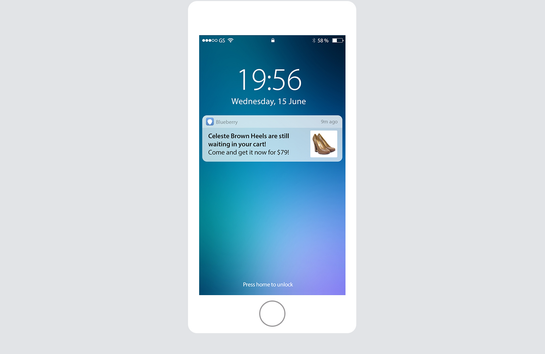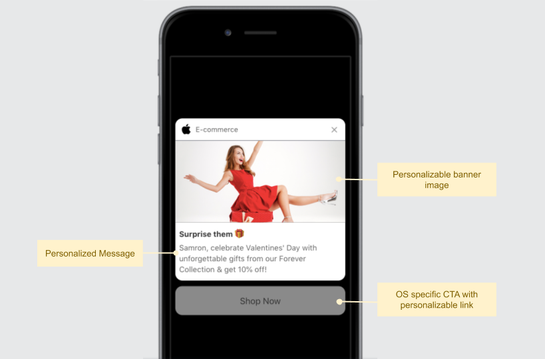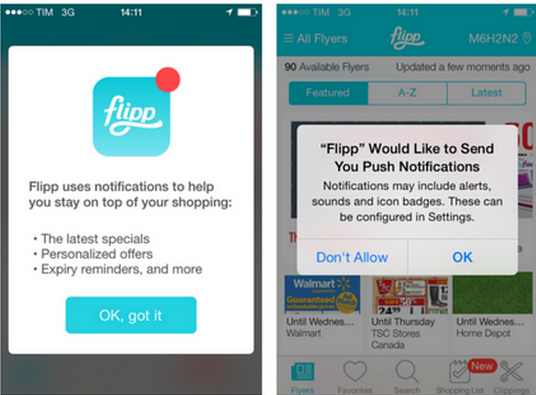Economic Downturn FAQ for Advertisers
Consider this post a breathing FAQ for all of your COVID-19 questions, with answers and effective management strategies from our team of marketing experts.
Read More
Ding! If you instinctively check your phone after every vibration and sound alert, you’re not alone. With 42% of mobile users enabling push notifications on their mobile devices, they’re the ultimate attention-grabber, serving as a serious driver for brands to increase conversion rates. Not so fast: Sending one too many push notifications can quickly push shoppers from interested to annoyed. That’s why developing an effective push notification strategy requires determining where that fine line is.
Here’s everything you need to know about using push notifications to drive growth and boost engagement.
Push notifications are alert messages that pop up on your phone’s lock screen or in-app. Brands can send push notifications if a user has their relevant app installed, and they have push notifications enabled on their phones. If you’ve received a message from a news app notifying you of top stories every morning or gotten pinged by Facebook because a friend tagged you in a photo, that’s a push notification in action. You can think of them as your device’s way of keeping you engaged with your apps.
Push notifications are a great way to recover abandoned carts.
Every device’s operating system has a unique push notification configuration. Apps can:
Push notifications are an immensely valuable tool to brands because they encourage customers to check their phones, open the app, engage with content, and take action, whether that’s making a purchase, signing up for a newsletter, or leaving a review. They’re also particularly useful when it comes to re-engaging users who have downloaded your branded app but haven’t interacted with it in some time.
“I’ll just send out push notifications whenever my traffic, conversions, or engagement takes a dip,” said the rookie marketer. Nope! The key to a successful push notification strategy is infrequency — you never want to spam users with irrelevant content.
Remember: The purpose of push notifications is to convey something worthwhile. It’s almost like you’re going up to a customer and tapping them on the shoulder. If you’re not here to say something relevant, important, or interesting, we guarantee they’ll start feeling a little peeved. After all, the last thing you want is for them to turn push notifications off, or even worse, uninstalling your app.
Here are some opportunities where you should definitely consider leveraging push notifications:
Every piece of marketing content you create should be actionable, whether it’s an email, digital ad, or physical flyer. Push notifications are no different — a strong push notification strategy involves knowing the exact purpose of what you’re sending. If you cannot pinpoint what value this message offers to a user, you’ll likely see low engagement rates.
Making your push notifications actionable all boils down to crafting a compelling CTA, which informs users exactly what action they need to take, including:
There isn’t a lot of space in a push notification. For example, iOS devices have a 178 character limit (anything else is cut off), while Android allows 65 characters for titles and 240 for descriptions. In other words, any messaging in your push notifications needs to be clear and concise.
This is where power words come in. They’re what savvy copywriters use in their messaging to trigger a psychological or emotional response in shoppers, boosting user engagement, retention, and click-through rates. (Check out this list of 200+ power words to bookmark.)
It’s not enough to craft push notifications that are valuable to all your customers — to create a killer push notification strategy, you also need to determine how they add value to each user. By personalizing push notifications, you can ensure that you’re targeting the right user at the right time with the right messaging.
What a personalized push notification might look like.
If that sounds like a daunting amount of work, don’t worry — most push notification platforms allow you to segment users into different audience groups and offer personalization opportunities such as:
Developed a perfect push notification strategy but are still struggling to see results? You probably have a permissions settings problem. No matter how fantastic your push notifications are, they’re pretty much worthless if users have disabled push notifications for your app.
Persuading users to opt-in will play a major role in your push notification strategy — 65% of users will open an app within 30 days once they enable push notifications. Rather than spamming new users with permissions requests, we encourage you to focus on building a relationship with them first. They need to trust your brand (and the fact that you’ll treat their devices with respect).
It’s better to ask for permission after, say, they complete their first purchase. You can then explain why enabling push notifications is helpful (in this case, they’ll be able to receive delivery updates).
An example of a splash screen that triggers an iOS opt-in message
Pro Tip: While you’re unable to customize opt-in messages for iOS devices, you can design a persuasive splash screen on your app that describes the benefits of users opting in.
While we’d love to provide you with all the answers, the truth is that you’ll only be able to determine your ideal CTA and messaging through testing, testing, and more testing. To complicate things even further, some creative might work better for particular audience segments. Your results might also vary depending on the cadence, delivery time, and purpose of your push notification.
Make sure to measure and optimize your push notification strategy over time. For an intro to A/B testing, check out this post.
The benefits of having a fantastic push notification strategy are huge — some studies have found that this tactic can increase app retention by 3-10 times. Even better, push notifications are constantly evolving, and there will likely be even greater opportunities for brands to personalize them and provide richer content in the future.
For more ideas on tools and tactics that’ll turbocharge your marketing efforts, check out the AdRoll Marketing Resource Library.
Last updated on April 23rd, 2025.


